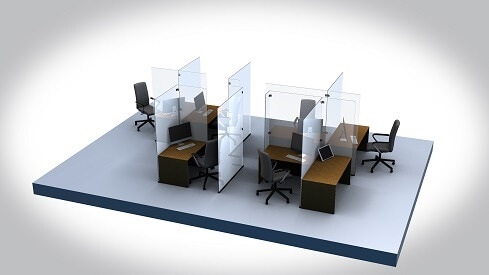Masked versus mask-less personnel? Dual-base versus single-base employees? What will the business workplace look like when all this is over? No one really knows yet.

Distancing has become a pillar of business resilience during the present pandemic. However, no one really knows whether what some are calling “remote-first” workplaces are the hallmark of a coming “new normal.”
Many people have been forced to work from home during the COVID-19 crisis. But ambivalence reigns on the matter of remote collaboration. Many of us are unsure whether to consider our homes our real offices or just conveniently remote, infection-free worksites until the crisis has abated.
Employers are just as stressed-out and uncertain as the rest of us. For example, many big tech vendors have extended their work-from-home policies into next year. But no major firm has taken the bold step of closing their traditional offices in favor of pervasive work-from-home arrangements.
Given the high degree of uncertainty on this matter, it seems strange that any business will make a major investment in new office space until the COVID-19 curve has been flattened once and for all. Curiously, Amazon did exactly that when it recently announced plans to open more than 900,000 square feet of new offices in New York, Phoenix, San Diego, Denver, Detroit and Dallas.
But how does this announcement jibe with the company’s express concern for its employees’ health and safety? Considering the ongoing issues with coronavirus infections at its fulfillment centers, Amazon should have spelled out how social distancing, face masks, and other measures will be used at the new facilities to keep employees safe and healthy.
Given Amazon CEO Jeff Bezos’ recent grilling by US Congress on the company’s personnel practices, this is an odd time for his firm to make such an announcement. Amazon seems to be betting that the pandemic will be history when it begins to staff these facilities. It also seems to be implying that remote collaboration will be peripheral to its operations under any likely future scenario.
If that’s the case, Bezos and his company would be out of step with what appears to be an economy-wide shift to remote office work. Remote work has been surprisingly successful as an adaptation strategy in this unusual period. The COVID-19 emergency has demonstrated that the economy can continue to chug along while many of us work from home. It’s no secret that usage of Zoom and other remote collaboration solutions has skyrocketed during this crisis, along with distance learning, remote medicine, and other technologies that replace in-person meetings of all sorts.
Emergence of the sustainable “new normal” office
Recognizing remote work as a good-enough tactic, people are not flocking back to traditional offices. As a Wall Street Journal article recently noted, “Empty-office syndrome appears to be self-perpetuating, as some return only to find that the workplace feels more isolating than home.”
Being mortal humans themselves, executives are not eager to overturn the apple cart of remote work. As reported in this recent WSJ article, a recent Microsoft survey of business leaders found that 82% planned to have more flexible work-from-home policies after the pandemic.
Nevertheless, ambivalence surrounding remote-work policies persists in the C-suite. For example, a Google study found “no difference in the effectiveness, performance ratings or promotions for individuals and teams whose work requires collaboration with colleagues around the world versus [employees] who spend most of their day to day working with colleagues in the same office.”
As this crazy year winds down, office managers everywhere will institute a first wave of “new normal” risk-mitigation practices that would have been considered unsustainable just as few months ago. Similar to what many of us have had to endure while patronizing dine-in restaurants and brick-and-mortar retailers, these practices will almost certainly include:
Lower-density office plans: Office layouts will be modified to spread desks further from each other and elevator capacities will be limited to ensure adequate distancing.
Prophylactic furnishings: Architects will redesign office plans so that desks are separated by plexiglass dividers and covered with plastic shields to prevent the spread of infection.
Contactless amenities: Facilities administrators will install touch-free doors, garbage cans, and restroom fixtures.
Directional passageways: People will be directed down one-way paths, hallways, and open spaces to ensure that they don’t risk coming close to others as they move through buildings.
Group-averse facilities: Offices will eliminate shared meeting rooms, copy/print rooms lunchrooms, coffee machines, gyms, and other infrastructure where groups would normally congregate.
Sanitization-intensive maintenance: Custodial staff will wipe down and disinfect all surfaces daily, while office administrators will distribute hand sanitizer, masks, gloves, and sanitary wipes to all parts of the office on a regular basis.
As we move into 2021, we’ll see business offices implement a second wave of more stringent and tech-intensive “new normal” practices:
Automated sanitization: Offices will be equipped with smart biosensors and robotic cleansing platforms that automate the sanitizing of spaces prior to allowing workers and customers to re-occupy them.
Automated monitoring: Smart cameras and thermal sensors will help facilities managers detect when non-quarantined people might bring infections into cleansed spaces. These apps will enable office managers to automatically trigger ingress restrictions, in-office warnings, automated cleansing tactics, and other infrastructure-based responses for preventing infection.
Automated distancing: Offices will require that people download and install proximity and biosensing apps to their smartphones prior to being allowed to enter sanitized spaces. These apps will provide individuals with AI-driven guidance for interacting at greater distances, or they may simply advise people to wash their hands and put on masks if they don’t wish to be promptly escorted from the facility.
A post-pandemic workplace schism in the making
Under most plausible post-pandemic scenarios, knowledge workers will probably be able to use group offices when they need to but be able to retreat to their homes and other remote-work sites when it suits them.
This “dual-base” option will almost certainly be available to most of the employees hired into the new Amazon facilities. They will be able to rely on remote collaboration, cloud computing, and other sophisticated technological tools to sustain productivity, regardless of whether they’re working out of a tech hub or their own basement office.
However, personnel whose jobs make it infeasible to work from home will have to run the gauntlet of these technology-intensive group-office risk-mitigation practices just to earn their daily bread. This latter class of “single-base” employee -- who some refer to as “deskless” -- may represent as much as 80% of the workforce. However, a more apt term going forward may be “masked employee,” considering that people such as hospital nurses, retail clerks, and hair stylists, who must work from sites other than their homes, may be required to wear face coverings on an ongoing basis.
Some see this as the foundation for a new workplace class system. We may replace the traditional “blue collar/white collar” dichotomy with “masked/maskless” personnel, based on whether they are required to work from sanitization-mandatory group worksites or have the option of working from their private home offices.
As the economy swings back from the current crisis and people are required to work in traditional group offices -- even occasionally -- this workplace segmentation will undoubtedly blur. Everybody, from the CEO on down, will need to keep a mask at the ready and keep a respectful six-foot distance throughout the workday. Under any likely scenario, that will be the only sustainable approach for keeping everybody safe, healthy, and productive.
For more content on remote work, follow up with these stories:
The Future of Work in a Post-COVID Era
About the Author(s)
You May Also Like







